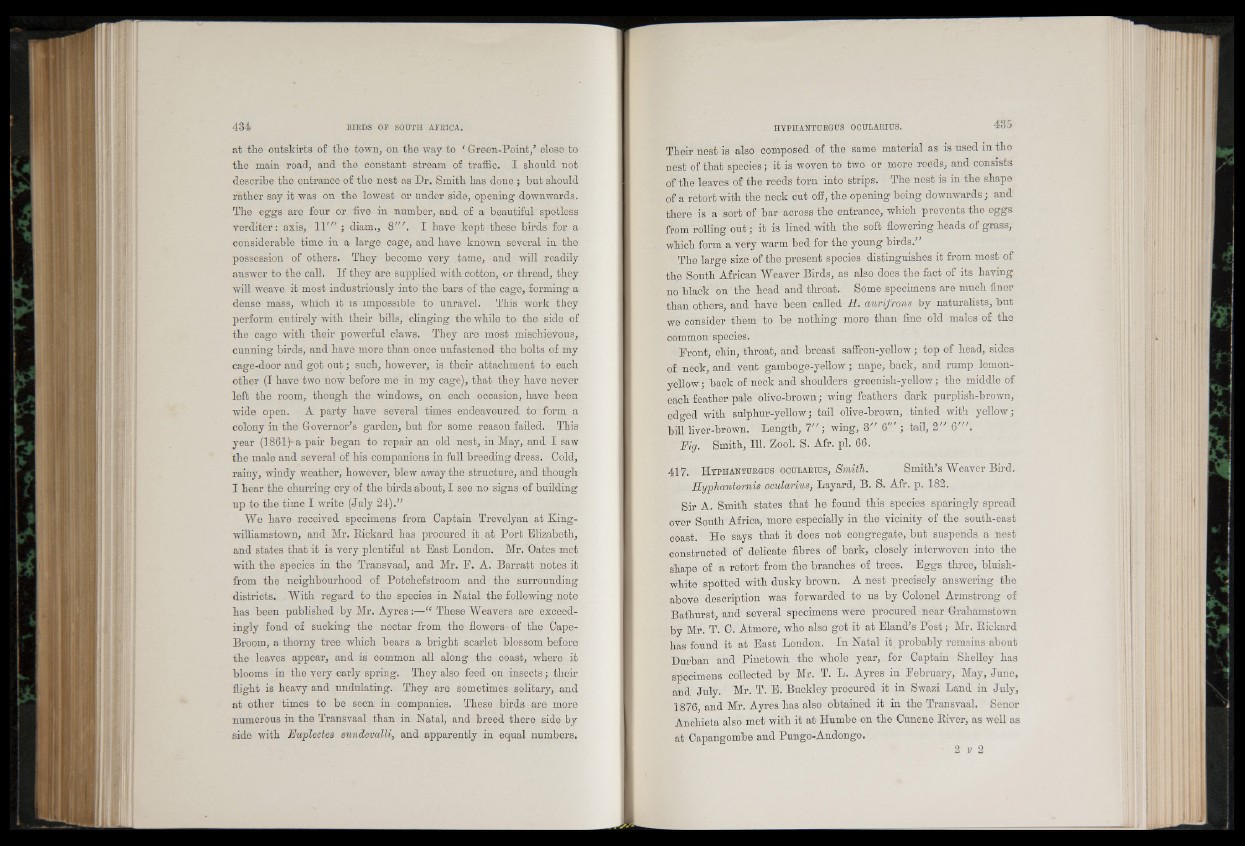
at the outskirts of the town, on the way to ‘ Green-Point,’ close to
the main road, and. the constant stream of traffic. I should not
describe the entrance of the nest as Dr. Smith has done; but should
rather say it was on the lowest or under side, opening downwards.
The eggs are four or five in number, and of a beautiful spotless
verditer: axis, l l ' / / ; diam., S'". I have kept these birds for a
considerable time in a large cage, and have known several in the
possession of others. They become very tame, and will readily
answer to the call. If they are supplied with cotton, or thread, they
will weave it most industriously into the bars of the cage, forming a
dense mass, which it is impossible to unravel. This work they
perform entirely with their bills, clinging the while to the side of
the cage with their powerful claws. They are most mischievous,
cunning birds, and have more than once unfastened the bolts of my
cage-door and got out; such, however, is their attachment to each
other (I have two now before me in my cage), that they have never
left the room, though the windows, on each occasion, have been
wide open. A party have several times endeavoured to form a
colony in the Governor's garden, but for some reason failed. This
year (1861)-a pair began to repair an old nest, in May, and I saw
the male and several of his companions in full breeding dress. Cold,
rainy, windy weather, however, blew away the structure, and though
I hear the churring cry of the birds about, I see no signs of building
up to the time I write (July 24).”
We have received specimens from Captain Trevelyan at King-
williamstown, and Mr. Eickard has procured it at Port Elizabeth,
and states that it is very plentiful at East London. Mr. Oates met
with the species in the Transvaal, and Mr. P. A. Barratt notes it
from the neighbourhood of Potchefstroom and the surrounding
districts. With regard to the species in Natal the following note
has been published by Mr. Ayres:—“ These Weavers are exceedingly
fond of sucking the nectar from the flowers- of the Cape-
Broom, a thorny tree which bears a bright scarlet blossom before
the leaves appear, and is common all along the coast, where it
blooms in the very early spring. They also feed on insects; their
flight is heavy and undulating. They are sometimes solitary, and
at other times to be seen in companies. These birds are more
numerous in the Transvaal than in Natal, and breed there side by
side with Fuplectes sundevalli, and apparently in equal numbers.
Their nest is also composed of the same material as is used in the
nest of that species; it is woven to two or more reeds, and consists
of the leaves of the reeds torn into strips. The nest is in the shape
of a retort with the neck cut off, the opening being downwards; and
there is a sort of bar across the entrance, which prevents the eggs
from rolling out; it is lined with the soft flowering heads of grass,
which form a very warm bed for the young birds.”
The large size of the present species distinguishes it from most of
the South African Weaver Birds, as also does the fact of its having
no black on the head and throat. Some specimens are much finer
than others, and have been called H. aurifrons by naturalists, but
we consider them to be nothing more than fine old males of the
common species.
Front, chin, throat, and breast saffron-yellow; top of head, sides
of neck, and vent gamboge-yellow; nape, back, and rump lemon-
yellow ; back of neck and shoulders greenish-yellow; the middle of
each feather pale olive-brown; wing feathers dark purplish-brown,
edged with sulphur-yellow; tail olive-brown, tinted with yellow;
bill liver-brown. Length, 7 " ; wing, 3" 6 " '; tail, 2" 6'".
Fig. Smith, 111. Zool. S. Afr. pi. 66.
417. H y ph a n t u r g u s o c u l a r iu s , Smith. Smith’s Weaver Bird.
Hyphantornis ocularius, Layard, B. S. Afr. p. 182.
Sir A. Smith states that he found this species sparingly spread
over South Africa, more especially in the vicinity of the south-east
coast. He says that it does not congregate, but suspends a nest
constructed of delicate fibres of bark, closely interwoven into the
shape of a retort from the branches of trees. Eggs three, bluish-
white spotted with dusky brown. A nest precisely answering the
above description was forwarded to us by Colonel Armstrong of
Bathurst and several specimens were procured near Grahamstown
by Mr. T. 0. Atmore, who also got it at Eland’s Post; Mr. Eickard
has found it at East London. In Natal it probably remains about
Durban and Pinetowh the whole year, for Captain Shelley has
specimens collected by Mr. T. L. Ayres in February, May, June,
and July. Mr. T. E. Buckley procured it in Swazi Land in July,
1876, and Mr. Ayres has also obtained it in the Transvaal. Senor
Anchieta also met with it at Humbe on the Cunene Eiver, as well as
at Capangombe and Pungo-Andongo.
2 f 2